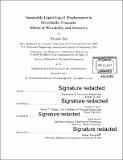| dc.contributor.advisor | Patrick S. Doyle. | en_US |
| dc.contributor.author | Lee, Hyundo | en_US |
| dc.contributor.other | Massachusetts Institute of Technology. Department of Mechanical Engineering. | en_US |
| dc.date.accessioned | 2018-02-08T16:28:29Z | |
| dc.date.available | 2018-02-08T16:28:29Z | |
| dc.date.copyright | 2017 | en_US |
| dc.date.issued | 2017 | en_US |
| dc.identifier.uri | http://hdl.handle.net/1721.1/113544 | |
| dc.description | Thesis: Ph. D., Massachusetts Institute of Technology, Department of Mechanical Engineering, 2017. | en_US |
| dc.description | Cataloged from PDF version of thesis. | en_US |
| dc.description | Includes bibliographical references (pages 153-174). | en_US |
| dc.description.abstract | Displacement of a fluid by an immiscible fluid occurs in various situations such as oil recovery in underground reservoirs, transport in the human body, and other interconnected network systems and porous media. We are motivated by oil recovery processes in geological porous media that take place at the micrometer scale, and focus in particular on the effects of wettability and geometry of microstructures on immiscible liquid-liquid displacements, that result from interactions in oil-water-rock systems. Microfluidic devices, micromodels, have been proposed as experimental test beds for reproducing flows in oil reservoirs in laboratory environments since they offer fine control over geometry and chemistry, and therefore provide insights into their effects on the process. These microfluidic devices are usually two-dimensional and transparent, with a simplified porous network designed to visualize and study fluid behavior in porous media. In oil reservoir research, the microfluidic test beds reflect underground oil reservoir conditions, for example, porosity, permeability, and wettability. The work in this thesis focuses on simple, additive micromodel fabrication techniques to build robust and reproducible structures in microfluidic channels and on the basic and fundamental understanding of immiscible displacement processes with simplified models and controlled flow conditions. We introduce two simple micromodel fabrication methods that can provide design flexibility with photopatterning, the ability to tailor wetting properties, and the calcium carbonate structure that is the most common constituent of oil reservoirs. We utilize a microscope projection lithography to construct polymeric structures with pre-defined wetting properties using a UV-initiated copolymerization method, and we are also able to make real-rock carbonate micromodels by incorporating calcium carbonate seed particles into microstructures and growing them with a supersaturated calcium carbonate solution. Using the micromodel fabrication methods thus developed, we have systematically explored oil-water immiscible displacement processes in a controlled manner with respect to various geometric and wettability conditions. With the fact that our flow experiment is in a small capillary number regime, we formulate a mathematical model for the oil-water displacement process with photopatterned structures of simple geometry and periodic patterns, and verify our theoretical model by matching it with our experimental observations, and we also conduct oil recovery model studies with encapsulated oil pockets with aqueous surfactant solution flooding. Lastly, based on the experience of calcium carbonate/hydrogel composite structuring and calcium carbonate growth from the structure, we expand our work and develop a method of making drug-laden hydrogel particles. By developing flexible methods to make microfluidic devices for immiscible fluids displacement study and investigation on the displacement process, we have been able to realize that microfluidic research with simplified conditions can enhance fundamental understanding of multiphase flow in natural, complex porous media. | en_US |
| dc.description.statementofresponsibility | by Hyundo Lee. | en_US |
| dc.format.extent | 174 pages | en_US |
| dc.language.iso | eng | en_US |
| dc.publisher | Massachusetts Institute of Technology | en_US |
| dc.rights | MIT theses are protected by copyright. They may be viewed, downloaded, or printed from this source but further reproduction or distribution in any format is prohibited without written permission. | en_US |
| dc.rights.uri | http://dspace.mit.edu/handle/1721.1/7582 | en_US |
| dc.subject | Mechanical Engineering. | en_US |
| dc.title | Immiscible liquid-liquid displacement in microfluidic channels : effects of wettability and geometry | en_US |
| dc.type | Thesis | en_US |
| dc.description.degree | Ph. D. | en_US |
| dc.contributor.department | Massachusetts Institute of Technology. Department of Mechanical Engineering | |
| dc.identifier.oclc | 1020180449 | en_US |
